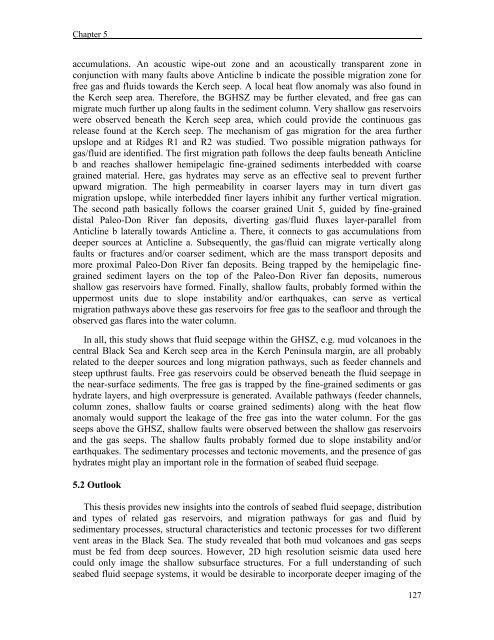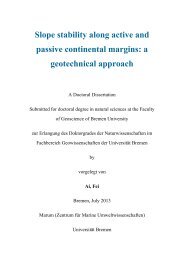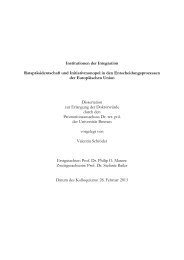Seismoacoustic Study of the Shallow Gas Transport and ... - E-LIB
Seismoacoustic Study of the Shallow Gas Transport and ... - E-LIB
Seismoacoustic Study of the Shallow Gas Transport and ... - E-LIB
Create successful ePaper yourself
Turn your PDF publications into a flip-book with our unique Google optimized e-Paper software.
Chapter 5<br />
accumulations. An acoustic wipe-out zone <strong>and</strong> an acoustically transparent zone in<br />
conjunction with many faults above Anticline b indicate <strong>the</strong> possible migration zone for<br />
free gas <strong>and</strong> fluids towards <strong>the</strong> Kerch seep. A local heat flow anomaly was also found in<br />
<strong>the</strong> Kerch seep area. Therefore, <strong>the</strong> BGHSZ may be fur<strong>the</strong>r elevated, <strong>and</strong> free gas can<br />
migrate much fur<strong>the</strong>r up along faults in <strong>the</strong> sediment column. Very shallow gas reservoirs<br />
were observed beneath <strong>the</strong> Kerch seep area, which could provide <strong>the</strong> continuous gas<br />
release found at <strong>the</strong> Kerch seep. The mechanism <strong>of</strong> gas migration for <strong>the</strong> area fur<strong>the</strong>r<br />
upslope <strong>and</strong> at Ridges R1 <strong>and</strong> R2 was studied. Two possible migration pathways for<br />
gas/fluid are identified. The first migration path follows <strong>the</strong> deep faults beneath Anticline<br />
b <strong>and</strong> reaches shallower hemipelagic fine-grained sediments interbedded with coarse<br />
grained material. Here, gas hydrates may serve as an effective seal to prevent fur<strong>the</strong>r<br />
upward migration. The high permeability in coarser layers may in turn divert gas<br />
migration upslope, while interbedded finer layers inhibit any fur<strong>the</strong>r vertical migration.<br />
The second path basically follows <strong>the</strong> coarser grained Unit 5, guided by fine-grained<br />
distal Paleo-Don River fan deposits, diverting gas/fluid fluxes layer-parallel from<br />
Anticline b laterally towards Anticline a. There, it connects to gas accumulations from<br />
deeper sources at Anticline a. Subsequently, <strong>the</strong> gas/fluid can migrate vertically along<br />
faults or fractures <strong>and</strong>/or coarser sediment, which are <strong>the</strong> mass transport deposits <strong>and</strong><br />
more proximal Paleo-Don River fan deposits. Being trapped by <strong>the</strong> hemipelagic finegrained<br />
sediment layers on <strong>the</strong> top <strong>of</strong> <strong>the</strong> Paleo-Don River fan deposits, numerous<br />
shallow gas reservoirs have formed. Finally, shallow faults, probably formed within <strong>the</strong><br />
uppermost units due to slope instability <strong>and</strong>/or earthquakes, can serve as vertical<br />
migration pathways above <strong>the</strong>se gas reservoirs for free gas to <strong>the</strong> seafloor <strong>and</strong> through <strong>the</strong><br />
observed gas flares into <strong>the</strong> water column.<br />
In all, this study shows that fluid seepage within <strong>the</strong> GHSZ, e.g. mud volcanoes in <strong>the</strong><br />
central Black Sea <strong>and</strong> Kerch seep area in <strong>the</strong> Kerch Peninsula margin, are all probably<br />
related to <strong>the</strong> deeper sources <strong>and</strong> long migration pathways, such as feeder channels <strong>and</strong><br />
steep upthrust faults. Free gas reservoirs could be observed beneath <strong>the</strong> fluid seepage in<br />
<strong>the</strong> near-surface sediments. The free gas is trapped by <strong>the</strong> fine-grained sediments or gas<br />
hydrate layers, <strong>and</strong> high overpressure is generated. Available pathways (feeder channels,<br />
column zones, shallow faults or coarse grained sediments) along with <strong>the</strong> heat flow<br />
anomaly would support <strong>the</strong> leakage <strong>of</strong> <strong>the</strong> free gas into <strong>the</strong> water column. For <strong>the</strong> gas<br />
seeps above <strong>the</strong> GHSZ, shallow faults were observed between <strong>the</strong> shallow gas reservoirs<br />
<strong>and</strong> <strong>the</strong> gas seeps. The shallow faults probably formed due to slope instability <strong>and</strong>/or<br />
earthquakes. The sedimentary processes <strong>and</strong> tectonic movements, <strong>and</strong> <strong>the</strong> presence <strong>of</strong> gas<br />
hydrates might play an important role in <strong>the</strong> formation <strong>of</strong> seabed fluid seepage.<br />
5.2 Outlook<br />
This <strong>the</strong>sis provides new insights into <strong>the</strong> controls <strong>of</strong> seabed fluid seepage, distribution<br />
<strong>and</strong> types <strong>of</strong> related gas reservoirs, <strong>and</strong> migration pathways for gas <strong>and</strong> fluid by<br />
sedimentary processes, structural characteristics <strong>and</strong> tectonic processes for two different<br />
vent areas in <strong>the</strong> Black Sea. The study revealed that both mud volcanoes <strong>and</strong> gas seeps<br />
must be fed from deep sources. However, 2D high resolution seismic data used here<br />
could only image <strong>the</strong> shallow subsurface structures. For a full underst<strong>and</strong>ing <strong>of</strong> such<br />
seabed fluid seepage systems, it would be desirable to incorporate deeper imaging <strong>of</strong> <strong>the</strong><br />
127
















